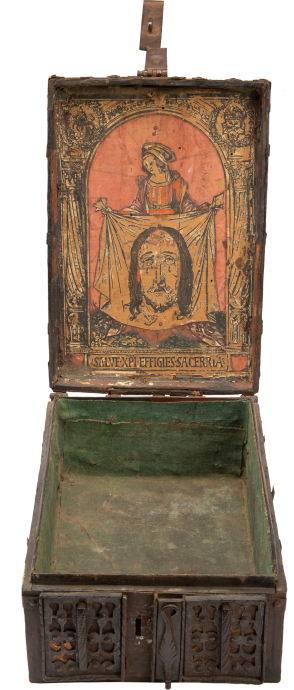


Hans Burgkmair the Elder
, c. 1509
Hans Burgkmair the Elder
Description
This coffret contains a rare print of Saint Veronica by Hans Burgkmair the Elder of Augsburg with hand-stenciled coloring from a Parisian workshop. While over 140 Gothic coffret prints survive today, most of these woodcuts were created in Paris by the atelier of the French artist Jean d’Ypres. This impression is one of the few coffret woodcuts known to originate outside of Paris. Printed in 1509 in Burgkmair’s shop, the impression was later imported to Paris where it was stencil-colored and affixed to the interior lid of its coffret around 1515. Only a few other impressions of this woodcut are known: One inside a coffret of approximately the same date and produced in the same workshop (Les Enluminures WOA 50368; formerly Jammes no. 28) and fugitive impressions in the Metropolitan Museum of Art (fig. 1) and the British Museum (fig. 2) This print is recorded in Hollstein (no. 269) and in Jammes (no. 27).
The print shows Saint Veronica standing in a meadow and gazing down at the Holy Vernicle she holds in both hands. The scene is enclosed by an architectural frame of a round arch supported by fluted columns and stylized Corinthian capitals on either side. Papal and Imperial arms are displayed in the upper corners, surrounded by wreaths. A xylographic inscription at the foot of the print reads: “SALVE.XPI.EFFIGIES.SACERRIA” (Hail, sacred image of Christ). It remains unknown how the impression first arrived in Paris, but similarities in the stencil technique and color palette to Parisian coffret prints indicate that it was stencil colored in a Parisian workshop (fig. 3). By comparison, colored impressions of Burgkmair’s Vernicle of German provenance display a much different color scheme (see fig. 2).
Hans Burgkmair, the Elder, (1473-c. 1531), was a painter and printmaker and one of the first German artists to show the influence of the Italian Renaissance. Some 700 woodcuts are ascribed to him, including his principal work, a series of 135 prints celebrating the triumphs of the emperor Maximilian I. His prints include some of the first chiaroscuro woodcuts, produced from two or more blocks inked with different tones to give gradations of light and shade. His son Hans Burgkmair the Younger (c. 1500–59) collaborated with him to produce the famous Turnierbuch (tournament book) of fifty-two illustrations published in 1530.
This coffret was once part of the largest single collection of Gothic coffrets formed by André and Marie-Thérèse Jammes, which was sold in 2007. The Jammes sale inspired new research by Severine Lepape, Sandra Hindman, and others on the typology and function of coffrets and their prints. A recent discovery of a Northern Renaissance painting of the Rest on the Flight, published by Hindman, reveals how coffrets were used. The painting includes a detail of a large, partially opened box containing a small leather-bound book with clasps, a rosary composed of precious gems, a brush, scissors, and two finger-rings all nest on diaphanous white cloth inside the box. This detail survives as the only known contemporary depiction of late-Gothic coffrets.
Literature
Pierre Bergé & Associes. Collection Marie-Thérèse et Andre Jammes: Coffrets de messagers, images du Moyen Age et traditions populaires, Paris, 2007, no. 27.
For other impressions of Burgkmair’s Vernicle woodcut see:
Bartrum, Giulia. German Renaissance Prints, 1490-1550, London, 1995, no. 129.
Hollstein, Friedrich W. H. German Engravings, Etchings, and Woodcuts, c.1400-1700, Amsterdam, 1954, vol. 6, no. 269.
Dackerman, Susan, Thomas Primeau, and Deborah Carton. Painted Prints: The Revelation of Color in Northern Renaissance and Baroque Engravings, Etchings, and Woodcuts, University Park (Pa.), 2002, pp. 112-113, no. 10.
Dodgson, Campbell. Catalogue of Early German and Flemish Woodcuts in the British Museum, London, 1903-1911, vol. 2, p. 77.
For general literature on coffrets and coffret prints see:
Field, Richard S. Fifteenth Century Woodcuts and Metalcuts from the National Gallery of Art, Washington D.C., Washington D.C., 1965.
Hindman, Sandra. “Gothic Traveling Coffers Revisited,” in Le Livre, La Photographie, L’Image & La Lettre: Essays in Honor of André Jammes, ed. Sandra Hindman, Isabelle Jammes, Bruno Jammes and Hans P. Kraus Jr., Paris, 2015, pp. 312-327.
Huyhn, Michel and Severine Lepape. “De la rencontre d’une image et d’une boîte: Les coffrets à estampe,” La Revue des Musées de France, 4 (2011), pp. 37-50.
Joseph Baer & Co., Catalogue 675, Codices manuscripti saeculorum IX. ad XIX.: Incunabula xylographica et typographica, Frankfurt, 1921.
Lepape, Severine. “Du nationalism au surréalism: Une petite histoire de coffrets,” Bulletin du Bibliophile, 1 (2012), pp. 11-23.
Lepape, Severine. “When Assemblage Makes Sense: An Example of a Coffret à Estampe,” Art in Print, 2 (2012), pp. 9-14.
Lepape, Severine, et al. Mystérieux coffrets: Estampes au temps de La Dame à la licorne, Paris, 2019.
Parshall, Peter W., Rainer Schoch, David S. Areford, Richard S. Field, and Peter Schmidt. Origins of European Printmaking, Washington, D.C.; New Haven, 2005.
Primeau, Thomas. “Coloring Within the Lines: The Use of Stencil in Early Woodcuts,” Art in Print, 3.3 (2013), pp. 11-16.
Schreiber, Wilhelm Ludwig. Handbuch der Holz- und Metallschnitte des XV. Jahrhunderts, 12 vols., Leipzig, 1926-1930.